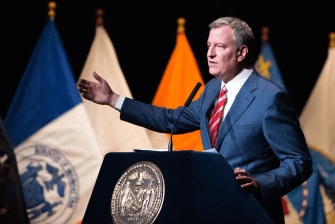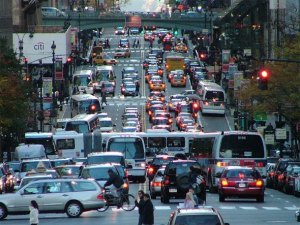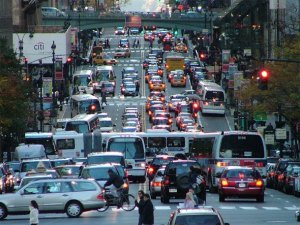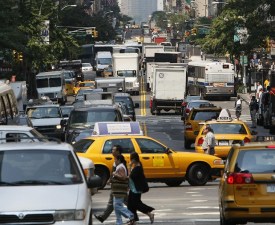De Blasio Is Wrong — There’s a Congestion Pricing Plan That Affects All Boroughs Fairly
The mayor says he's never seen a version of congestion pricing that's fair to the outer boroughs, but the Move NY toll reform plan is specifically designed to distribute costs fairly between different parts of the city.
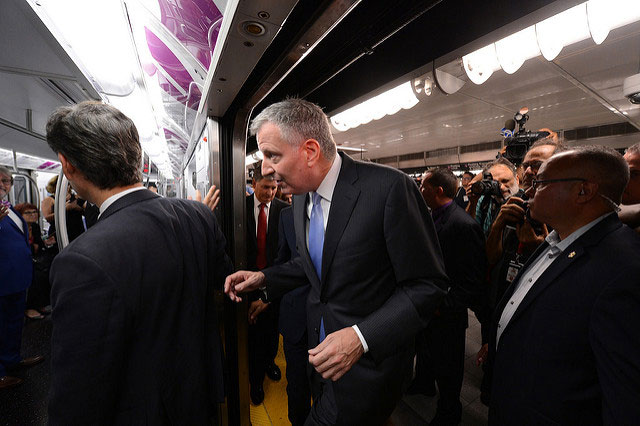
Over the weekend, Governor Andrew Cuomo told the Times that he’s warming to congestion pricing — a political breakthrough for streets and transit policy in New York City. With Cuomo’s support, there is now a feasible political path for road pricing for the first time since 2009. The potential benefits for transit, biking, and walking are enormous.
But getting a plan enacted won’t be easy. A decade ago, when the Bloomberg administration made a push to enact congestion pricing, the plan was vociferously attacked by representatives from the city’s more car-dependent districts in a campaign bankrolled by the deep-pocketed parking garage industry. One elected official who sided with this anti-congestion pricing coalition was Bill de Blasio, who voted against the Bloomberg proposal as a council member in early 2008.
De Blasio’s stance on toll reform has shifted over the years (he was for a watered-down version of Richard Ravitch’s 2009 bridge toll plan). Now that congestion pricing is gaining momentum, however, he seems to be reverting to his earlier position.
Last week the mayor sidestepped questions on congestion pricing from Fox5 by saying, “I’ve always had a lot of concerns about it, to be honest with you. I’ve never been in favor of those proposals because I haven’t seen one that I thought was fair particularly to folks in the outer boroughs.”
That response might have applied to the 2008 congestion pricing plan, which called for tolling motorists entering Manhattan below 60th Street while leaving other tolls intact and barely charging for-hire vehicles, which are overwhelmingly used by Manhattan residents.
The Bloomberg congestion plan passed the City Council but sank in the State Assembly, weighed down by borough resentment against tolling the entrances to Manhattan while people who lived there accrued the most obvious benefits.

Ironically, rejecting the Bloomberg plan only compounded outer-borough tolling inequities, when the state legislature later authorized the MTA to shore up its finances by raising tolls every two years on its seven NYC bridges, which largely serve the city’s more car-dependent districts.
To make congestion pricing politically viable, “Gridlock” Sam Schwartz devised a plan that shifts much of the toll burden to Manhattan. The Move NY plan does it via this one-two punch:
Toll swap. Move NY puts a price on driving into Manhattan Central Business District while shaving $2.50 each way off the current E-ZPass $5.76 toll on the four major MTA bridges (Triborough, Whitestone, Throgs Neck, Verrazano); $1.00 each way off the $2.64 toll on the Henry Hudson Bridge; and $1.00 each way off the $2.16 Marine Park and Cross Bay Bridges. The Move NY authorizing legislation locks in the ratio of these tolls to the Manhattan CBD toll, ensuring that the MTA can’t later roll back the outer borough toll swap without upping the congestion charge itself.
For-hire surcharges. Instead of paying the Manhattan CBD tolls, all for-hire vehicles — yellow and green cabs as well as app-based services such as Uber and Lyft — would pay surcharges of $0.60/mile and $0.20/minute for travel in Manhattan’s “taxi exclusion zone” (below 96th Street on the East Side, below 110th Street on the West Side); charges would be halved on weekends.
The toll swap makes Move NY much fairer for car owners from Queens, which has five interborough crossings where tolls would be reduced, and the Bronx, which has four. It’s also central to the logic that undergirds Move NY’s approach to traffic reduction — that tolls should be unavoidable where congestion is most prevalent and transit provision is strongest, and lower where congestion is less prevalent and transit is weaker.
The for-hire surcharges, meanwhile, will raise taxi and ride-service fares by 12 percent, on average, ensuring parity with the private car congestion toll. Disincentivizing for-hire trips will also lead to allow double-digit improvements in vehicle speeds in the Manhattan core — gains that will benefit for-hire drivers by increasing turnover and ridership. Conversely, a surcharge on for-hire trips without concurrently tolling private car and truck trips would stunt those increases in average speeds, removing the carrot but keeping the stick and thus inciting opposition from for-hire vehicle owners, drivers, and passengers.
Here, then, is how the Move NY toll plan tackles the issue of fairness that de Blasio raised last week:
- Under the 2008 congestion pricing proposal, residents of Manhattan would have borne just 13 percent of all new net tolls and surcharges, and only 22 percent of charges paid by city residents — a toll burden less than that of Queens and Brooklyn.
- Under the Move NY toll-swap plan, residents of Manhattan will pony up 22 percent of the new net charges and 36 percent of charges paid by city residents — by far the largest toll and surcharge share borne by any borough or county.
If Mayor de Blasio didn’t know that before, he should now.

